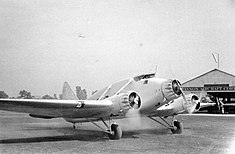 A Stinson Model A in standard trimotor configuration | |
| Accident | |
|---|---|
| Date | 31 January 1945 |
| Summary | Fatigue failure of wing structure |
| Site | Spring Plains, Victoria 37°01′12″S 144°33′59″E / 37.0200°S 144.5663°E |
| Aircraft | |
| Aircraft type | Stinson Model A (modified) |
| Aircraft name | Tokana |
| Registration | VH-UYY |
| Flight origin | Melbourne |
| Stopover | Kerang, Victoria |
| 2nd stopover | Mildura, Victoria |
| Destination | Broken Hill, New South Wales |
| Passengers | 8 |
| Crew | 2 |
| Fatalities | 10 |
| Survivors | 0 |
On 31 January 1945 a Stinson Model A aircraft departed from Melbourne for a flight of 127 nautical miles (235 km) to Kerang, Victoria—the first leg of an Australian National Airways regular scheduled service to Broken Hill, New South Wales. It crashed 50 nmi (93 km) from Melbourne. All ten occupants were killed in the accident. The aircraft was one of four Stinsons imported in 1936 by Airlines of Australia (AoA). Three had now crashed with the loss of 17 lives, and the fourth would not be permitted to fly again.
It was determined that the accident was caused by a fatigue crack in the main spar of the left wing that caused the outer part of the left wing, outboard of the engine nacelle, to separate from the remainder of the aircraft. The expert panel investigating the accident believed this to be the first fatal aircraft accident anywhere in the world directly attributable to metal fatigue.

The accident and related matters were investigated by a Supreme Court judge who also found that the aircraft's left wing failed in flight due to a fatigue crack. The judge made five recommendations including one that a safe flying life should be fixed for each metal aircraft registered in Australia to avoid further failures due to metal fatigue. This practice is now called safe-lifeing.